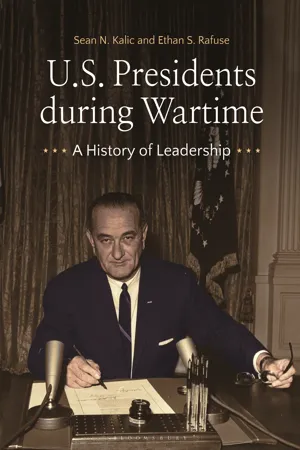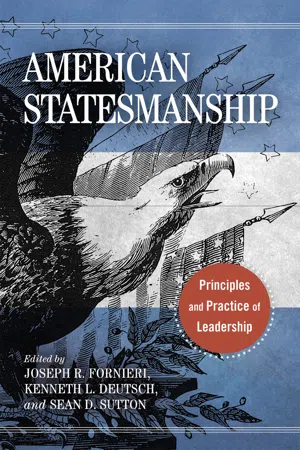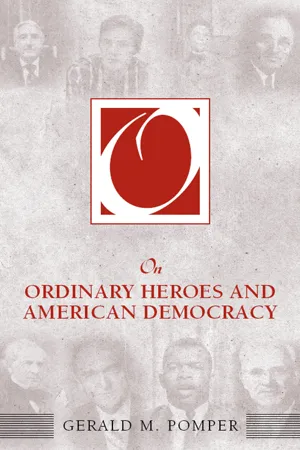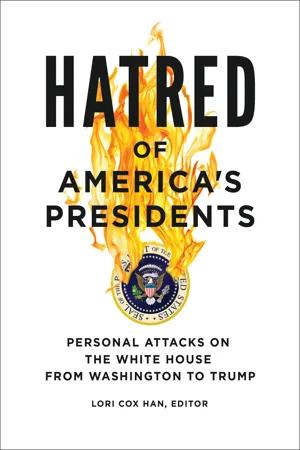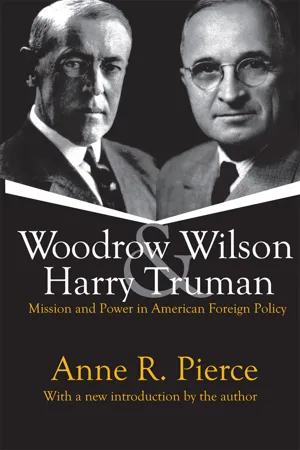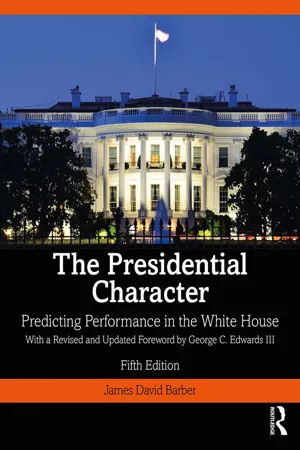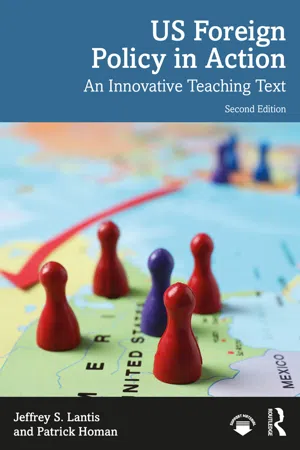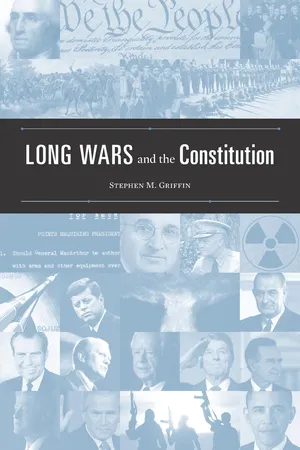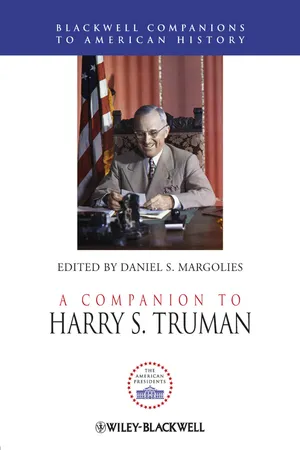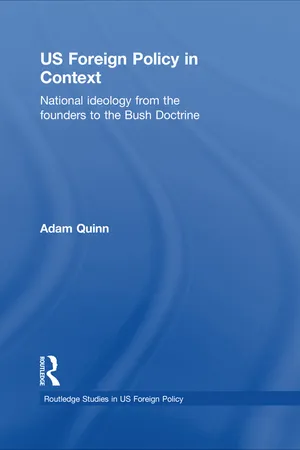History
President Truman
President Truman, the 33rd President of the United States, served from 1945 to 1953. He is best known for making the decision to drop atomic bombs on Hiroshima and Nagasaki, effectively ending World War II. Additionally, Truman implemented the Marshall Plan to aid in the reconstruction of Europe and played a key role in the founding of the United Nations.
Written by Perlego with AI-assistance
Related key terms
10 Key excerpts on "President Truman"
- eBook - ePub
U.S. Presidents during Wartime
A History of Leadership
- Sean N. Kalic, Ethan S. Rafuse(Authors)
- 2023(Publication Date)
- Bloomsbury Academic(Publisher)
Harry S. TrumanOverviewParty: DemocraticYears in Office: 1945–1953Secretaries of War/Defense: Robert P. Patterson (1945–1947), Kenneth C. Royall (1947), James V. Forrestal (1947–1949), Louis A. Johnson (1949–1950), George C. Marshall (1950–1951), Robert A. Lovett (1951–1953)Major Conflicts: End of World War II (1945) and Cold War, Korean War (1945–1953)Adversaries: Axis powers (Germany and Japan), the Soviet Union, China, North KoreaHarry S. Truman has the distinction of being the president of the United States at the end of World War II as well as the president at the start of the Cold War. This is a unique distinction, as these two eras represent two very different periods in the history of the United States. As part of this history, Truman made the decision to use the atomic bomb against Japan to hasten the collapse of Japanese resistance and provide an end to the war without the need for an invasion of the Japanese home islands. With the successful conclusion of World War II, Truman immediately faced the onset of the Cold War and presided over the development of a national security and defense structure that prepared the United States for a long ideological struggle against the Soviet Union.Harry S. Truman (1945). (Library of Congress Prints and Photographs Division)Throughout his tenure as president, Truman faced a rough road, as the United States struggled to negotiate the transition between the end of World War II and the start of the Cold War. Truman wrestled with momentous economic, diplomatic, and military decisions that profoundly reshaped the role of the United States in the international security environment. However, by the time the United States got involved in the Korean War in 1950, the public’s perception of Truman as a strong and capable president had eroded, as the Soviet Union and its communist allies seemed to be expanding around the globe. By the time he left office in 1952, Truman was not a highly rated president. However, as the Cold War lingered and evolved, historians came to recognize that Truman had built a resilient and strong grand strategy for the Cold War. Therefore, his characterization as a weak president quickly transitioned to a new image that focused on the strong foundations Truman built during the first years of the Cold War. Truman’s tenure during the end of World War II, as well as the start of the Cold War, makes him an interesting and dynamic wartime president. - eBook - ePub
American Statesmanship
Principles and Practice of Leadership
- Joseph Fornieri, Kenneth Deutsch, Sean Sutton, Joseph R. Fornieri, Kenneth L. Deutsch, Sean D. Sutton(Authors)
- 2021(Publication Date)
- University of Notre Dame Press(Publisher)
CHAPTER 19 Harry S. Truman American Statesmanship in World War and Cold WarELIZABETH EDWARDS SPALDINGS etting aside Richard Nixon, Harry S. Truman holds the dubious distinction in Gallup polls of exiting office the least popular president of the modern era. Setting aside Donald Trump, Truman also scores the lowest approval rating average for time in office.1 “To err is Truman” was a catchy, common verdict on his presidential statesmanship. Truman was often characterized as an impatient, simple, and limited leader who walked in the shadow of Franklin D. Roosevelt. His administration’s actions during the Korean War led to greater disparagement of Truman, who was famous for saying that “the buck stops here” with the president. Only two years before he succeeded Roosevelt as president in 1945, however, Truman graced the cover of Time magazine as “Investigator Truman,” the chairman of an important, nationally known US Senate committee that saved billions of dollars and the lives of countless armed forces in wartime. Time also featured him several more times on its cover, including, impressively, two times as Man of the Year: for 1945, after winning World War II through the decision to use atomic weapons against Japan, and for 1948, after his stunning come-from-behind victory in the presidential election of that year. In presidential polls of recent years—whether scholarly or popular—Truman now ranks in the near-great category. What could explain such up-and-down changes in judgment? The answer lies in a careful consideration of President Truman’s statesmanship.The Man from IndependenceForever linked with his hometown of Independence, Truman is often called “the man from Missouri.” Born in 1884 in Lamar, Missouri, Truman hailed from a loving, close-knit, and hardworking family. Morality and virtue were modeled by parents and grandparents alike to Truman, his brother, and his sister. After moving to Independence, Missouri, sixyear-old Truman fell in love with his future wife Bess Wallace when they met in Sunday school. His poor eyesight meant he had to wear thick, fragile glasses, which came with doctor’s orders to avoid sports and rough games, and a couple of years later he suffered a life-threatening bout of diphtheria. With the encouragement of his college-educated mother, he read widely and played piano, and he began his lifelong walking habit through drills with the neighborhood boys in the Junior Militia that they started for fun during the Spanish-American War. Truman formed a classical understanding of history and politics by reading, frequently and repeatedly, volumes such as the Bible, The Lives of Great Men and Famous Women (edited by Charles Francis Horne), Plutarch’s Lives, Marcus Aurelius’s Meditations, Edward Gibbons’s The Decline and Fall of the Roman Empire, the works of Shakespeare and Twain, Sir Edward Creasy’s Fifteen Decisive Battles of the World - eBook - ePub
- Gerald M. Pomper(Author)
- 2016(Publication Date)
- Routledge(Publisher)
33 They deserve commendation as much for their political abilities as for their humanitarianism. In only a few months, Truman led the United States to reverse its traditional stance toward the world, garnered large resources for the new course of action, and won the support of both political parties and the general electorate. Politics, not simply good intentions, accomplished a daring and innovative foreign policy.The President and the PresidencyPresidential choices certainly reflect the personal characteristics and the governing style of the individual men, like Truman, who make them. Such decisions are also critically shaped by the institutional character of the office and the circumstances of their historical period. Truman exemplifies these relationships. He would later offer a pithy description of the job of the chief executive: “I sit here all day trying to persuade people to do the things they ought to have sense enough to do without my persuading them…. That’s all the powers of the President amount to.”34 His terse description was particularly appropriate to the Marshall Plan, a program clearly of benefit to the United States but one that required adroit use of the bounded powers of the president. It illustrates well “the tensions in the American system that exist between restraints deriving from the institutional framework on the one hand and programs of action and presidentially driven solutions on the other.”35Of course Truman did not bring the Marshall Plan to life by himself. He was neither its intellectual creator nor its sole political sire. A president is not a biblical prophet or a divine lawgiver, a single, all-powerful individual who delivers truth and justice to a receptive people. Rather, a president is a democratic politician who must take ideas, wherever found, and win consent from a contentious citizenry. That was Truman’s task—and his achievement.The presidency has been evaluated in very different ways in American history and scholarship. We often rank presidents according to their “greatness,” placing Washington, Lincoln, and the two Roosevelts at the top, with Buchanan and Harding at the bottom. We can describe the president’s powers in Woodrow Wilson’s expansive terms: “The president is at liberty, both in law and conscience, to be as big a man as he can be. His capacity will set the limit.”36 Or we can minimize them, in the words of James Lord Bryce, as “the same in kind as that which devolves on the chairman of a commercial company or the manager of a railway.”37 - eBook - ePub
Hatred of America's Presidents
Personal Attacks on the White House from Washington to Trump
- Lori Cox Han(Author)
- 2018(Publication Date)
- ABC-CLIO(Publisher)
33. Harry S. Truman Born: May 8, 1884 Died: December 26, 1972 Time in Office: 33rd President of the United States, April 12, 1945, to January 20, 1953 Election Results: 1944 Election: Elected vice President, assumed office upon death of Franklin D. Roosevelt; 1948 Election: 49.5% of popular vote, 303 (57.1%) Electoral College votes Spouse: Bess Wallace (m. 1919) Children: MargaretHarry S. Truman served as the 33rd president of the United States. A U.S. senator from Missouri, Truman was picked by Franklin D. Roosevelt to be his running mate in the 1944 presidential election. The Roosevelt-Truman ticket defeated the Republican nominees Thomas E. Dewey and John Bricker in a popular vote (53.4% to 45.9%) and Electoral College (432–99) landslide. On April 12, 1945, Roosevelt died of a cerebral hemorrhage and Truman became president. In 1948 he survived doubts about whether he would even be nominated again, and faced what most considered to be a hopeless quest for reelection against Dewey, who had been renominated by the Republican Party. But in one of the great upsets in presidential electoral history, Truman defeated Dewey by more than 4% in the popular vote. He also secured a relatively easy victory in the Electoral College, winning 303 to Dewey’s 189. Strom Thurmond, the candidate of the Dixiecrats, a southern-based offshoot of the Democratic Party, won 39 electoral votes. Truman declined to run again in 1952. In total, he served just shy of two terms. Truman married Bess Wallace in 1919, and they had one daughter, Margaret.The story of Truman and the “hatred” meted out at him and his administration takes two broad forms. The first surrounds his perceived inability and unpreparedness to take over and fill Roosevelt’s giant shoes. Although Truman soon won many skeptics over, he constantly had to push back against those who believed that the pressures of the presidency would soon see him crumble. His stunning reelection in 1948 went a long way to dispel those doubts. Second, whatever respect he could garner in the wake of large policy achievements, such as his decisive move to drop the atomic bomb and bring World War II to a close, his controversial decision to desegregate the military, and his reelection, the ceaseless trickle of bad news of scandal and corruption by his subordinates fed a vision of Truman as a crony politician. He remained decisive on any number of unpopular decisions, such as the firing of the popular General Douglas MacArthur for insubordination, but these led Truman to become increasingly defensive in the waning days of his administration. He left office with only a 32% approval rating according to one poll, and he was widely considered at the time to be a failed president. However, that assessment has undergone a profound change in the decades since he left the Oval Office. - eBook - ePub
Woodrow Wilson and Harry Truman
Mission and Power in American Foreign Policy
- Anne Pierce(Author)
- 2017(Publication Date)
- Routledge(Publisher)
Part II Harry TrumanPassage contains an image
Chapter 6 The Lessons of Two World Wars: Truman Emends and Enhances the Internationalist TraditionToday, the entire world is looking to America for enlightened leadership to peace and progress. Such a leadership requires vision, courage and tolerance. It can be provided only by a united nation deeply devoted to the highest ideals.(Address before the Joint Session of Congress, April 16, 1945)Much has been made of the evolution of American foreign policy during Truman's first term as president. Truman's earlier foreign policy is said to be idealistic, his later realistic. His earlier foreign policy is supposed to exhibit the internationalist concerns of Woodrow Wilson, his later "power politics." His earlier foreign policy is supposed to reflect the "acquiescent approach" toward the Soviet foreign policy of Franklin D. Roosevelt, his later to reflect an intolerance of anything "Soviet." Many analysts of the Cold War divide the years from 1945 to 1949 into "periods"; for example, viewing U.S. policy toward Russia in terms of shifts from "universalism" to "firmness and patience" to "containment." We shall see that such assessments of Truman's foreign policy are partly correct. However, they belie the fundamental aspects of American foreign policy, which remained the same during these years.First, Truman consistently and fervently sought to uphold the ideals of the United States. He became unwilling to compromise with the Soviets in part because he came to believe that that would mean the compromising of those principles which distinguished and blessed us. His harder line toward the Soviets signaled no rejection of ideals for the sake of the realities of power, but rather the belief that "deals" with the Soviets should be put off until the power configuration was such that we could make deals advantageous to our way of life. Second, from the beginning to the end of his tenure, Truman placed himself within the internationalist tradition and described his indebtedness to Woodrow Wilson. Although Truman emended that tradition and deviated from the path Wilson laid out for him, throughout his presidency he praised and referred to Wilson more than he did any other president. He saw the United States' realization of its responsibilities in the world, which culminated in his presidency, as the partial fulfillment of Wilson's dreams. Third, in spite of changing assessments of the Soviet Union and changing rhetoric toward it, from 1945 to early 1949, Truman consistently took no concrete action to deprive Russia of its hold on Eastern Europe. Although he quickly rejected Roosevelt's belief that cooperating with the Soviet Union would lead them to cooperate with us, he maintained Roosevelt's passive stance toward the Soviet sphere of influence. Where wartime agreements had legitimized that sphere and where the Red Army had already established its authority, Truman chose to endure, although not to approve of, Soviet hegemony. - eBook - ePub
The Presidential Character
Predicting Performance in the White House, With a Revised and Updated Foreword by George C. Edwards III
- James Barber(Author)
- 2019(Publication Date)
- Routledge(Publisher)
Near the end of his Presidency Truman wrote his daughter that "Your dad will never be reckoned among the great. But you can be sure he did his level best and gave all he had to his country. There is an epitaph in Boothill Cemetery in Tombstone, Arizona, which reads, 'Here lies Jack Williams; he done his damndest.' What more can a person do?"Truman's main difficulties as President arose when he had to—or felt he had to—react swiftly to an external demand for decision, such as at his press conferences. The decision to drop the first atomic bomb and the decision to intervene militarily in Korea were of this type. In both cases he leapt over the first phases of his decision-making process and quickly reached a choice which involved, as it turned out, the direst consequences. But as he developed wider experience the great initiatives of his administration also emerged—the Truman Doctrine, the Marshall Plan, NATO, Point Four. Under his leadership, the policy of containing Communism by preventive military and economic shoring up of regions threatened by Soviet expansionism developed its positive thrust, particularly in Europe. This is not the place to go into what that eventually came to or how it all might have been different. From the perspective of the Presidency, Truman took massive initiatives at a time when such initiatives seemed unlikely, given the circumstances of his accession to the office, his own qualifications, and the condition of the country.Harry Truman liked to say that "When you're at the bottom you've got no place to go but up." In 1946, his fortunes dipped close to the wrong end of the barrel. After Roosevelt's death the country had rallied around him, as Americans do in a Presidential crisis. Then the Gallup poll gave him 87 percent approval—three percent higher than FDR's top rating. A year and half later, as the Congressional elections approached, Truman was down to 32 percent. The nation was in a surly mood. The war was over and people wanted to get on with the rich full life. Roosevelt was dead, Churchill turned out of office, the great crusade which had united the country—and suppressed all its ordinary conflicts—was done with. Yet what the people found was sky-rocketing inflation, black markets, continual strikes, meat shortages, quarrels among the armed services, firings at the top of the government, the housing shortage, fears about the new atomic bomb, partisan battles in Congress, and growing rifts among the wartime allies. The climate of expectations called for a time of reassurance and recovery, after all the sacrifice and moral uplift of the war. A large part of the public did not find Truman reassuring. He got it from all sides: both the Communists and the unions were against him, while the Republicans berated him for being soft on Communism and unions. Whatever was wrong with the Presidency, the Republicans, out of power since 1933, could claim it was none of their doing, and urge throwing the rascals out. As usual, these emotions focused on the man in the White House. The slogan "Had enough?" got a strong play. Pundits such as Walter Lippmann pronounced their solemn judgments: - eBook - ePub
US Foreign Policy in Action
An Innovative Teaching Text
- Jeffrey S. Lantis, Patrick Homan(Authors)
- 2022(Publication Date)
- Routledge(Publisher)
had also become the first country to develop and use the atomic bomb, the most powerful weapon ever known to humankind. In 1939, at the urging of scientists including Albert Einstein, President Roosevelt ordered a secret research project for the bomb. Dubbed the Manhattan Project, this involved hundreds of scientists working in secure laboratories across the U.S. to harness the power of atomic fission. After a successful test of an atomic device in July 1945, President Harry Truman decided to use these weapons to help end the war against Japan. U.S. planes dropped atomic bombs over Hiroshima and Nagasaki in early August 1945, and the Japanese empire eventually sued for peace. Some 2,500,000 Japanese soldiers and civilians lost their lives in the war. President Truman and his top advisors rightly believed that nuclear weapons gave the U.S. a strategic advantage, but Soviet leaders were already set on a crash course to develop one of their own. The ensuing U.S.–Soviet arms race became the focus of widespread concerns about nuclear proliferation in the decades to come. 5 The Cold War: Values and Interests The seeds of Cold War strife between the U.S. and the Soviet Union were sown in disagreements when they were allies and trying to decide the future of Europe. During the war, U.S. presidents and top officials began to embrace a much wider set of national interests than had many prior generations of leaders. American values like support for democracy and political freedoms, they believed, should be promoted throughout the world. Presidents Roosevelt and Truman espoused these ideals in meetings of allied leaders. At the “Big Three” Yalta meeting in the Soviet Union in February 1945, for example, President Roosevelt, Winston Churchill, and Josef Stalin agreed to a de facto division of Europe into Western- and Soviet-dominated blocs (see Map 4.1). This spheres of influence arrangement became the lens through which many leaders viewed post-war European cooperation - eBook - ePub
- Stephen M. Griffin(Author)
- 2013(Publication Date)
- Harvard University Press(Publisher)
2 Truman and the Post-1945 Constitutional OrderThe beginning of the Cold War was a watershed for U.S. foreign policy. This is the period running roughly from Stalin’s speech in February 1946, appearing to promise a conflict with capitalism, to President Truman’s 1950 decision to intervene in Korea and massively expand the armed forces.1 As summarized by historian George Herring, “the Truman administration in the short space of seven years carried out a veritable revolution in U.S. foreign policy. It altered the assumptions behind national security policies, launched a wide range of global programs and commitments, and built new institutions to manage the nation’s burgeoning international activities.”2This period has been extensively studied by historians, but there has been an absence, especially in general accounts, of assessment of the constitutional significance of epochal events such as the Truman Doctrine, the formation of NATO, and the Korea decision.3 At the same time, historians have shown that officials were aware that the nature of the constitutional order was changing.4 According to Michael Hogan’s insightful account, there was an unceasing debate, centered on fears of a coming “garrison state,” over the effect the new global responsibilities of the United States would have on American government and society.5 How would the coming “long war” affect the Constitution?In this chapter, I will describe how political elites convinced themselves, the government, and the public that the pre–Pearl Harbor constitutional order was inadequate to the challenging circumstances that the U.S. faced in the Cold War. From the point of view of the executive branch, questions of war powers had to be subordinated to the larger objectives of that policy. Within a short span of time the U.S. moved from the pre–Pearl Harbor constitutional order in which Congress was understood to be the gatekeeper for war, amid generally robust interbranch deliberation, to the uneasy establishment of a new post-1945 constitutional order. That order rejected the idea that Congress had a check on presidential war power independent of its appropriations authority. When this rejection was combined with an expansion in the capabilities of the U.S. military as compared with the situation prior to Pearl Harbor, the consequence was that President Truman and his successors had the ability to initiate war on their own authority. - eBook - ePub
- Daniel S. Margolies(Author)
- 2012(Publication Date)
- Wiley-Blackwell(Publisher)
This chapter divides into two sections. The first discusses Truman's political standing going into the election, key events during the early part of 1948, and the president's nomination and recall of Congress. In this part, the chapter relies primarily, though not exclusively, on the works of Truman's best-known biographers. Its approach is chronological, with some analysis and discussion of how scholars have interpreted the events of campaign before September 1948. The second half of the chapter covers the autumn campaign, its outcome, and its significance – topics which students of the Truman presidency have debated a bit more forcefully. That part reviews the scholarly literature and reads like a work of historiography. Clearly, after 60-plus years, scholarly understanding of the 1948 election has reached a high level of maturation and sophistication. Nevertheless, not everything about this contest has been written, and aspects of it merit closer scrutiny.The Road to the Nomination
There is some question about how much trouble Truman was in as 1948 approached. Many problems associated with America's reconversion to a peacetime economy, such as the advent of strikes, were confined to the first two years of the administration, when the president lost public support and control of Congress. Inflation, of course, remained an ongoing concern in 1947 and 1948. But the contemporary “misjudgment,” as Ferrell (1983: 187) called it, of Truman as an ill-prepared, overwhelmed, and somewhat undignified chief executive seemed to be changing. According to Alfred Steinberg (1962), a former journalist who had covered the Truman White House, the president gained popularity during 1947. “The unrelenting attacks upon him began to backfire,” Steinberg observed, “and he won wide support for a foreign policy based on humanitarian principles” (p. 298). That sentimental comment on Truman's diplomacy aside, 1947 was the year of the Truman Doctrine and the Marshall Plan. At home, the president addressed concerns about communism by establishing a loyalty program for federal employees. He also strove to defend the achievements of the New Deal from assaults by the Republican-controlled Eightieth Congress and mended fences with labor by vetoing the Taft–Hartley Act. Although Congress overrode the veto, Truman's opposition to the law, which placed restrictions on the rights of unions, allowed him to recapture the initiative domestically and, as the Nation - eBook - ePub
- Adam Quinn(Author)
- 2009(Publication Date)
- Routledge(Publisher)
Rather than pre-emptive efforts to avert war through American commitment, the United States’ chief response was Congress’s passage of a series of Neutrality Acts in 1936, 1937 and 1939, prospectively limiting trade with belligerents in wartime so as to avoid a recurrence of 1917’s casus belli. Ultimately, however, America did not stay out of the Second World War. This was due partly to the efforts of President Franklin Roosevelt to aid the Allied side, and partly to the decision of Japan to attack the United States at Pearl Harbor in December 1941, and that of Hitler’s Germany to declare war immediately thereafter. 2 This chapter focuses on the period after that conflict was won. It does so because it considers the years of the mid- and late 1940s, under the leadership of Harry Truman, to be a decisive moment in the history of US strategic thought and policy. It was in this period that the decision to embrace a fully engaged global internationalism took place. Certainly there had been internationalist individuals in the United States before, and a strand of national life given over to their way of thinking. But it was only after the Truman administration’s period in office that a stable bipartisan consensus existed in favour of extensive American commitments to preserve global order and to maintain the military capability to meet such commitments. This chapter argues that the Truman administration made the case for, and commitment to, a new American internationalism on the basis of a revival of Wilsonian principles of liberal universalism and the Rooseveltian argument for accumulating armed strength in the defence of a righteous civilizational cause. In doing so, it broke decisively with the ideology of the Founders’ Era consensus, which finally lost the last of its hold over the thinking of American political leaders
Index pages curate the most relevant extracts from our library of academic textbooks. They’ve been created using an in-house natural language model (NLM), each adding context and meaning to key research topics.
